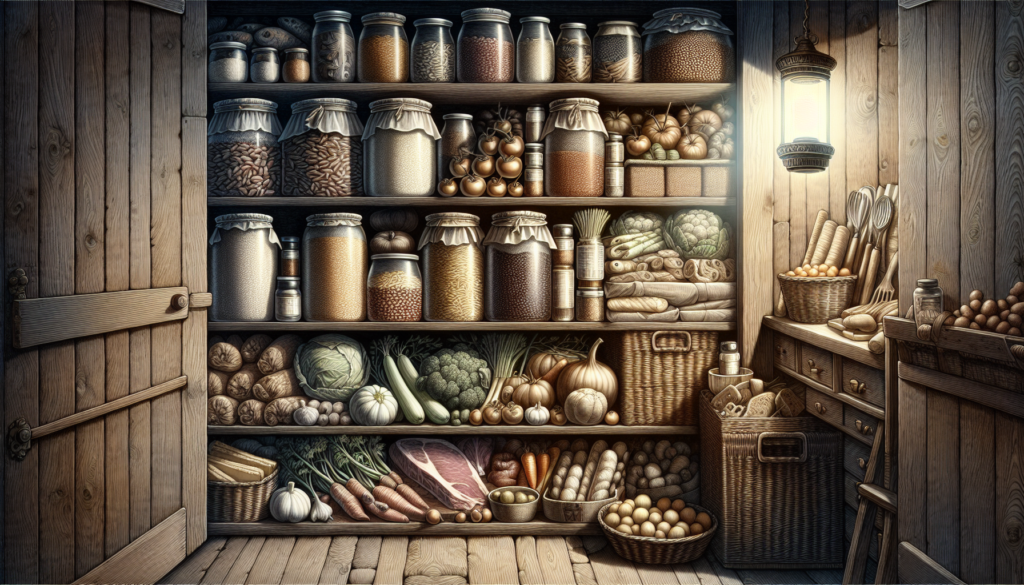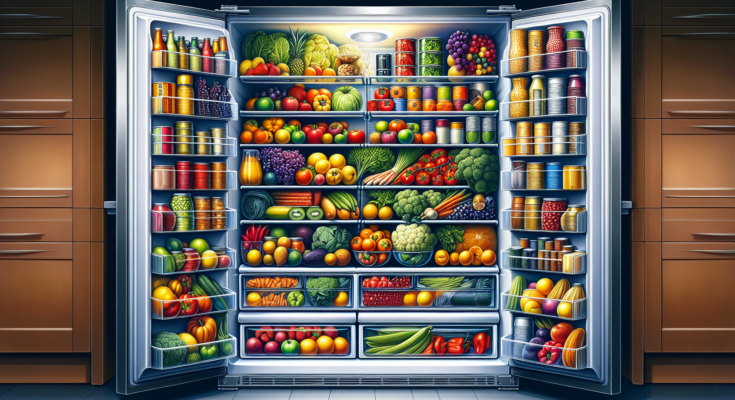Struggling to fill your fridge without draining your wallet? Learn how to stock your fridge on a budget with our straightforward advice designed for real-life budgets. This article will walk you through savvy shopping tips, essential foods that offer bang for your buck, and fridge organization tactics that bring down costs. Get ready to make every dollar stretch further, while keeping a well-stocked fridge that supports your healthy eating goals.
Key Takeaways
- Plan your grocery budget based on your income and track your spending to prevent impulse buys and save money.
- Stock up on pantry staples with long shelf lives and versatile ingredients that can be used in various dishes to reduce frequent shopping trips.
- Utilize strategic meal planning, sales, and discount cycles to cut costs, and embrace seasonal produce to enjoy fresher ingredients at lower prices.
Table of contents
- Key Takeaways
- Budgeting for Your Grocery Bill
- Essential Foods with Long Shelf Life
- Strategic Meal Planning
- Smart Shopping Techniques
- Fridge Organization for Savings
- Versatile Ingredients for Various Dishes
- Utilizing Sales and Discounts
- Preserving Food to Extend Shelf Life
- Adapting to Seasonal Changes
- Summary
- Frequently Asked Questions
Budgeting for Your Grocery Bill
Facing high grocery bills can feel daunting. However, you can manage your spending without sacrificing the quality of your food, beginning with a carefully planned grocery budget. A detailed budget not only combats overspending but also promotes healthier, more nutritious food choices, potentially saving money over time.
It’s like building a dam to hold back the flood of unnecessary expenses, allowing you to channel your funds into meals that nourish your body and delight your taste buds.
Setting a Realistic Grocery Budget
Designing a feasible grocery budget requires consideration of your income, essential expenses, and dietary habits to ensure smooth sailing throughout the month. Financial experts suggest allocating 10-15% of your household income to groceries, but this is more of a compass direction rather than a strict rule.
Peek into your past grocery receipts to anchor your budget in reality, and remember that dietary preferences, such as gluten-free or organic choices, might require a bigger slice of the pie.
Tracking Your Spending
Upon setting your budget, diligently track your spending to maintain focus. This is akin to maintaining a logbook for your culinary journey. Use a weekly grocery list as your map, ensuring you only dock at the aisles you need. This proactive approach helps you steer clear of the siren call of impulse buys and keeps your grocery bill on course.
Essential Foods with Long Shelf Life
Imagine a pantry that’s a treasure chest of long-lasting, nutritious food, ready to be whipped into a variety of delicious meals. Opting for foods with a long shelf life not only conserves money but also combats the significant issue of wasted food and food waste.
Think of unleavened breads and canned fish as your trusty sidekicks in this quest, offering both nutritional value and an almost mythical longevity.
Pantry Staples That Last
Consider your pantry as a storeroom where you keep your supplies to fend off hunger and inflated prices. Stock it with basic foods like grains such as quinoa and brown rice, and robust vegetables like potatoes and beets. These staples are your knights in shining armor, ready to defend against the need for frequent shopping trips.
And don’t forget the powerful allies in canned goods; they’re the trusty steeds that will carry you through many a meal with their convenience and shelf-stability.
Refrigerator Must-Haves
Within the chilly confines of the refrigerator, longevity reigns supreme. Citrus fruits, apples, and sturdy veggies like cauliflower and radish are the noble residents of this realm. They last long and serve faithfully in a variety of dishes, while versatile proteins like bacon and shredded cheddar are the knights ready to joust with hunger at a moment’s notice.
Strategic Meal Planning
Embarking on the journey of meal planning promises a wealth of savings and diminished food waste. Here are some tips to get you started:
- Plan your meals ahead, charting a course for lunches and dinners to avoid the costly ports of fast food and convenience meals.
- Embrace a crew of cost-effective, plant-based proteins and versatile grains.
- Avoid recipes that call for exotic, expensive spices that you’ll only use once.
By following these tips, you can save money and reduce food waste through meal planning.
Crafting a Weekly Meal Plan
Your weekly meal plan serves as a guide, navigating you through sales and accommodating family preferences. Start by scouting the horizon for local store sales and plotting a course that respects the limits of your budget and to be aware of your weekly budget. Involve your crew – your family – to ensure everyone’s tastes are charted on the map, guaranteeing smooth sailing through the week.
Incorporating Leftovers into Meals
Leftovers can be likened to discovering a resource-rich, unexplored island. Get creative and repurpose them into new and exciting dishes that extend their value and add variety to your meals.
A citrus salad can be transformed into a zesty addition to an egg salad sandwich, creating new flavors and reducing waste.
Smart Shopping Techniques
Smart shopping parallels a savvy pirate seeking the best treasures. Stick to your list like a treasure map, and don’t be tempted by the mermaid’s song of unplanned spending. Keep a spyglass on prices per unit and navigate through the high seas of different stores to uncover the true treasures – the most economical purchases.
Choosing Affordable Fresh Produce
As the summer sun intensifies, so does the craving for refreshing treats and fresh, seasonal produce. But rather than wilting under the heat of high prices, turn to the bounty of the season. Choosing fresh fruits and other produce in its peak season is like catching the trade winds – it’s economical and yields the freshest flavors.
And don’t overlook the troves of frozen veggies; they’re like preserved treasures that extend the bounty of the harvest year-round.
Bulk Buying Basics
Bulk buying is akin to a robust galleon, capable of transporting a large quantity of supplies. Larger quantities of dry goods and meats often come with a smaller price tag, allowing you to stock your hold for less coin.
Repackage these treasures into smaller parcels to manage your storage space and keep your cargo from spoiling.
Fridge Organization for Savings
For a well-organized fridge and fresh provisions, commence with a thorough cleaning. Remove all items, scrub the decks, and make sure everything is shipshape for your budget-friendly bounty.
Clear containers act like glass-bottomed boats, keeping your stock in view and ensuring no food is left to lurk unseen in the depths.
Using Airtight Containers
Sealing your sliced produce in airtight containers will keep them as fresh as a sea breeze. It’s like having little treasure chests that safeguard your fruits and veggies from the harsh environment outside.
Maximizing Space and Visibility
A well-organized fridge is like a well-mapped archipelago; you know where every island is and what it holds. Dispose of expired items to avoid hidden dangers, and use clear storage solutions to make sure every morsel is easy to spot.
Understand the climate of each region – the varying temperatures and humidity settings – and place your food accordingly to keep it fresher, longer.
Versatile Ingredients for Various Dishes

Filling your kitchen with versatile ingredients equates to possessing a chest of keys, each opening up the potential for a plethora of delicious meals. Some versatile ingredients to have on hand include:
- Olive oil
- Soy sauce
- Mushrooms
- Potatoes
- Eggplant
These ingredients are the golden staples and chameleons of the kitchen, adapting to any culinary challenge you throw at them.
From Ground Beef to Other Meats
Broadening your meat variety is similar to enlarging your fleet, providing more options to satisfy hunger. Chicken thighs are the sturdy workhorses, offering rich flavor and versatility for less gold than their breast counterparts.
And don’t overlook the humble pork shoulder; it can be transformed into a feast fit for a captain with a little slow cooking.
Gluten-Free and Special Diets
Managing gluten-free or special diets does not necessarily equate to braving a storm. Staples like eggs and canned beans guide you to delicious, diet-friendly meals without breaking the bank.
Utilizing Sales and Discounts
Just as the wisest sailors identify the most favorable winds, astute shoppers recognize the most advantageous sales. Wednesdays can be a goldmine, as grocery stores hoist new sales flags, and sometimes you can still catch the tailwind of last week’s deals.
Timing Purchases with Sales Cycles
To fully leverage sales, it’s necessary to comprehend their cycles, similar to understanding the lunar phases. Keep a price book like an astrolabe, guiding you to stock up when prices hit their lowest ebb. Learn the seasonal trends and promotional currents to take advantage of frugality.
Loyalty Programs and Coupons
Joining a loyalty program is like being part of an exclusive trading alliance, offering you benefits and discounts that others may not get. Use coupons like letters of marque, granting you permission to slash prices and save coin, especially on double coupon days.
Preserving Food to Extend Shelf Life
Food preservation is akin to map-making, prolonging the lifespan of your food discoveries for prolonged enjoyment. Whether you’re freezing bread or using MAP to keep your goods fresh, you’re ensuring that your provisions withstand the test of time.
Freezing and Thawing Best Practices
Freezing is like sending your food into stasis, halting bacterial growth and preserving its essence. Label your frozen treasures with the date and contents. Make sure you know what’s below deck and prevent any losses to freezer burn. Using a freezer bag can further ensure the freshness and organization of your food.
DIY Preservation Methods
DIY preservation is your chance to be an alchemist, transforming abundant seasonal fruits into long-lasting gold. Berries, for instance, can be set on a tray like jewels, frozen, and then bagged for future feasts.
Adapting to Seasonal Changes
As the seasons progress throughout the year, a resourceful cook adjusts their menu to align with the shifting bounty. Embrace the cornucopia of spring and summer produce, and use seasonal guides as your star charts to navigate the best deals and flavors.
Embracing Seasonal Produce
The peak of harvest season is the prime time for fruits and vegetables, when their flavor and nutritional value are at their zenith. By incorporating seasonal ingredients into your recipes, you’re not only savoring the best of nature but also ensuring your gold coins stretch further.
Preserving Seasonal Fruits and Vegetables
Preserving seasonal produce is like mapping new territories for future exploration. Use freezing, drying, and canning to keep the harvest’s bounty within reach, even as the seasons change. From making jam to quick pickling, there are myriad ways to bottle the essence of the seasons for year-round enjoyment.
Summary
We’ve learned that a well-stocked fridge on a budget isn’t just a distant shore; it’s a treasure island within our grasp. We’ve navigated budgeting, shopping, and meal planning strategies that promise a bounty of savings. Remember, with a little ingenuity and planning, you can feast like a king without paying a king’s ransom. So unfurl your sails and set a course for a kitchen kingdom rich with flavor and savings.
Frequently Asked Questions
Review your income and mandatory expenses to understand how much you can allocate towards groceries. Experts suggest spending about 10-15% of your household income on food, but adjust based on your dietary needs and preferences.
You should always have items like rice, pasta, canned beans, potatoes, and carrots in your pantry, as they are versatile and can be used to create many different nutritious meals.
You can save money on fresh produce by buying fruits and vegetables that are in season and considering frozen options for a longer shelf life. Try these tips next time you go grocery shopping!
The best way to store leftovers is in clear, airtight containers in the fridge or freezer. Label them with the date and contents to keep track and encourage using them up in other meals.
To make the most of sales and discounts at grocery stores, join store loyalty programs, use coupons, and plan your shopping trips around sales cycles. Keep an eye out for special promotions and consider buying in bulk when items are on sale. Happy savings!




